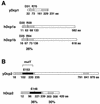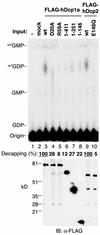Identification of a human decapping complex associated with hUpf proteins in nonsense-mediated decay
- PMID: 12417715
- PMCID: PMC134073
- DOI: 10.1128/MCB.22.23.8114-8121.2002
Identification of a human decapping complex associated with hUpf proteins in nonsense-mediated decay
Abstract
Decapping is a key step in general and regulated mRNA decay. In Saccharomyces cerevisiae it constitutes a rate-limiting step in the nonsense-mediated decay pathway that rids cells of mRNAs containing premature termination codons. Here two human decapping enzymes are identified, hDcp1a and hDcp2, as well as a homolog of hDcp1a, termed hDcp1b. Transiently expressed hDcp1a and hDcp2 proteins localize primarily to the cytoplasm and form a complex in human cell extracts. hDcp1a and hDcp2 copurify with decapping activity, an activity sensitive to mutation of critical hDcp residues. Importantly, coimmunoprecipitation assays demonstrate that hDcp1a and hDcp2 interact with the nonsense-mediated decay factor hUpf1, both in the presence and in the absence of the other hUpf proteins, hUpf2, hUpf3a, and hUpf3b. These data suggest that a human decapping complex may be recruited to mRNAs containing premature termination codons by the hUpf proteins.
Figures







References
-
- Bai, R. Y., C. Koester, T. Ouyang, S. A. Hahn, M. Hammerschmidt, C. Peschel, and J. Duyster. 2002. SMIF, a Smad4-interacting protein that functions as a co-activator in TGFβ signalling. Nat. Cell Biol. 4:181-190. - PubMed
-
- Beelman, C. A., and R. Parker. 1995. Degradation of mRNA in eukaryotes. Cell 81:179-183. - PubMed
-
- Beelman, C. A., A. Stevens, G. Caponigro, T. E. LaGrandeur, L. Hatfield, D. M. Fortner, and R. Parker. 1996. An essential component of the decapping enzyme required for normal rates of mRNA turnover. Nature 382:642-646. - PubMed
MeSH terms
Substances
LinkOut - more resources
Full Text Sources
Other Literature Sources
Molecular Biology Databases
